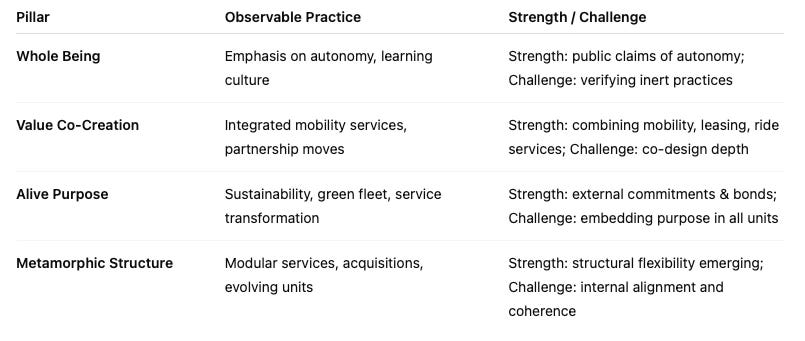Autonom - Case Study
A Mobility Network Embedding Autonomy, Learning, and Purpose in a Legacy Sector
Context and Overview
Founded: 2006 in Piatra Neamț, Romania
Business: Autonom offers integrated mobility solutions: short and medium-term car rental, operational leasing, fleet management, transfers with driver, equipment lease, roadside assistance, used vehicle sales
Scale & Reach: ~600 employees, 46 agencies, presence in ~33 cities in Romania and Hungary, fleet over 16,000 vehicles as of recent reports
Growth & Innovation Moves: Autonom has issued sustainability-linked bonds, secured €15 million EIB financing to expand electric and hybrid vehicles, and invested in adjacent mobility services (e.g. acquiring stake in a taxi firm)
Cultural Claims: On the website is mentioned that organisational model is based on “small teams, autonomy, flexibility, transparent communication and decentralized decision-making”
Autonom lands in the category of Alive Organisation — which is remarkable especially in a sector often dominated by rigid logistics, cost pressure, and asset-heavy operations.
1. Whole Being – Autonomy, Values & Human Development
Strengths / Observations:
Autonom emphasizes autonomy, flexibility, and transparent communication in its public statements.
They frame themselves as a “learning company” that invests in personal and professional development of colleagues.
The founders reference Stoic philosophy, focusing on staying true to principles and managing what one can control in decisions. This may anchor a deeper inner culture of resilience and purpose.
2. Value Co-Creation – Mobility as a Co-Designed Ecosystem
Manifestations:
Autonom’s service portfolio is broad: it acts not only as a traditional rental/leasing company, but also provides fleet management, chauffeur services, equipment lease, and used-car sales — indicating integrated value chains.
Collaboration with insurers (Hellas Direct → Autonom Protect) shows moves toward embedding adjacent services and co-creating with financial / risk partners.
Their investment in an Uber-style taxi service (Blue) and stake in Meridian taxi firm suggests bridging between rental/leasing and mobility/ride services — pushing toward a co-designed urban mobility ecosystem.
Their sustainability financing with European Investment Bank (EIB) is conditional on green vehicle deployment — effectively co-creating environmental value with public sector money.
3. Alive Purpose – Sustainability, Mobility, & Community
Signs of a Superior Purpose:
Autonom has published a Sustainability Strategy, targeting reductions in carbon footprint: –25% by 2025, –51% by 2030
Their EIB-backed investment specifically for green vehicles underlines serious alignment of purpose with operations.
The acquisition of a taxi stake and creation of electric mobility (Blue) signals an ambition to shift beyond vehicle leasing to influencing mobility systems.
Their growth narrative emphasizes doing business with integrity, helping customers, and principled decision-making.
4. Metamorphic Structure – Adapting in a Legacy Field
Structural Indicators of Aliveness:
Decentralized decision-making and small teams.
Diversified divisions (Rent, Lease, Drive, Fleet, AutoRulate) suggests modular business units that can evolve independently.
M&A activity: Autonom has actively acquired 11 companies in 5 years across sectors (finance, tech, mobility) — implying structural embedding of new capabilities.
Bonds and external financing tied to sustainability criteria create structural feedback loops connecting capital markets and operations.
Governance and Decision Flow
Possible/Observable Features:
Executive decisions appear influenced by sustainability metrics (e.g. EIB green funding).
The transparency of values and principles is publicly asserted; thus, governance may use principle-based guidelines rather than rigid rules.
The issuance of sustainability-linked bonds binds financial governance to purpose outcomes.
The acquisition of Meridian stake, launch of Blue, and growth strategy suggest strategic decisions are dynamic and context-responsive.
Systemic Integration
Autonom shows multiple signals of alignment, but the full living integration is still emergent and fragile.
Lessons for Others
Walk the talk of autonomy – decentralisation must be supported by capability, systems, and trust.
Embed purpose in capital, not just words – connect financing (bonds, loans) to impact metrics.
Orchestrate ecosystems, not just services – collaborate with public transit, micro-mobility, cities.
Design feedback loops between divisions – ensure data flows across rental, leasing, fleet, and new mobility ventures.
Use acquisitions as purpose alignment tests – new units must align structurally and culturally, not just financially.
Conclusion
Autonom offers a compelling local example of a company striving to become an Alive Organisation in a capital-intensive and operationally complex sector.
While many of the aliveness pillars are in motion — autonomy, learning, modular services, sustainability commitments — the journey is still in progress.
If Autonom will continue to lock in deep structural coherence, embed feedback loops, and maintain cultural integrity amid expansion, they could stand as a very powerful case from the Romanian context.
Enjoy reading and applying these materials. If you’d like to receive additional information regarding Alive Organisations topic please subscribe below.


